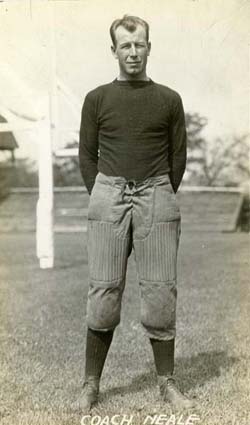
The USC Trojans football program represents the University of Southern California in the sport of American football. The Trojans compete in the Football Bowl Subdivision (FBS) of the National Collegiate Athletic Association (NCAA) and the Big Ten Conference.

Alfred Earle "Greasy" Neale was an American football and baseball player and coach.

John Arthur Banaszak is an American football coach and former player. He was formerly the head football coach at Robert Morris University. Banaszak played in the National Football League (NFL) with the Pittsburgh Steelers from 1975 to 1981. He is a three-time Super Bowl champion. Banaszak was a starter at right defensive end for the Steelers in Super Bowl XIII and Super Bowl XIV. He later played in the United States Football League (USFL), winning a championship as a starting defensive end for the Michigan Panthers in 1983. Banaszak played for Michigan in 1983 and 1984 and for the Memphis Showboats in 1985.

The 1922 Rose Bowl was a college football bowl game played on January 2, 1922, between the Washington & Jefferson Presidents (W&J) and the California Golden Bears. It holds several distinctions including being the only scoreless Rose Bowl Game, the first tie in a Rose Bowl, the first African-American quarterback to play in the Rose Bowl, the first freshman to play in a Rose Bowl, and Hal Erickson (W&J) became the only man ever to play in two Rose Bowls, with two teams, without losing. It was also the last to be played at Tournament Park and to be officially known as the Tournament East-West Football Game, and with only 450 students at the time, Washington & Jefferson College was the smallest school to ever play in a Rose Bowl.

The Washington & Jefferson Presidents are the intercollegiate athletic teams for Washington & Jefferson College. The name "Presidents" refers to the two presidential namesakes of the college: George Washington and Thomas Jefferson. W&J is a member of the Presidents' Athletic Conference, the Eastern College Athletic Conference, and play in Division III of the National Collegiate Athletic Association in both men's and women's varsity sports. During the 2005–2006 season, 34 percent of the student body played varsity-level athletics.

The Washington & Jefferson Presidents football team represents Washington & Jefferson College in collegiate level football. The team competes in NCAA Division III and is affiliated with the Presidents' Athletic Conference (PAC). Since its founding in 1890, the team has played their home games at College Field, which was remodeled and renamed Cameron Stadium in 2001.
Mike Sirianni is an American football coach and former player. He is currently the head football coach for Washington & Jefferson College in Washington, Pennsylvania, a position he has held since the 2003 season after succeeding Pittsburgh Steelers great John Banaszak. Sirianni has compiled a record of 101–24 in 11 seasons as head coach. Sirianni's winning percentage of .846 is second best among active head coaches with at least five years of experience in NCAA football, trailing only that of Mount Union coach Larry Kehres, for whom he played for. In his first 11 years of coaching at Washington & Jefferson, he won PAC Coach of the Year five times.

The 1921 college football season had no clear-cut champion, with the Official NCAA Division I Football Records Book listing California Golden Bears, Cornell Big Red, Iowa Hawkeyes, Lafayette Leopards, Washington & Jefferson Presidents, and Vanderbilt Commodores as champions. Only California, Cornell, Iowa, and Lafayette claim national championships for the 1921 season.
Alfred J. "A.J." Pagano is a former college football player for Washington & Jefferson College. During his playing career, he was one of the most prominent NCAA Division III football players, gaining national attention and honors.

Robert Martin "Mother" Murphy was an administrator at Washington & Jefferson College; his efforts to improve the Washington & Jefferson Presidents football team directly led to its development as a national powerhouse during the early 20th century.

The 1921 Washington & Jefferson Presidents football team represented the Washington & Jefferson College during the 1921 college football season. Coached by Greasy Neale, went 10–0 in the regular season, defeating Pitt, University of Detroit, and Syracuse. The 7–0 victory over rival Pitt was celebrated with a day of canceled classes and a bonfire with inspirational speeches in front of the Washington County Courthouse. As the best team from the east, W&J was invited to the 1922 Rose Bowl to play the best team from the west: the undefeated and heavily favored California Golden Bears. Some had even begun to call Cal the best team in college football history. The Red and Black sent 20 men on the cross-country trip and Robert M. Murphy mortgaged his home to pay his six family members’ way. W&J would be the last Rose Bowl team to play the same 11 men the entire game. During the train ride to Pasadena, in which Greasy Neale continued to prepare his men, Lee Spillers caught pneumonia and could not finish the journey. Ross "Bucky" Buchannan, a reserve player who had stowed away on the train and was fed smuggled sandwiches during the trip, was available to fill Spillers' roster spot.









